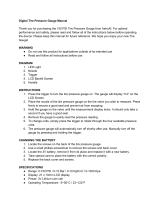7+,6&217$,1(56+28/'
%(9,68$//<,163(&7('
$)7(5$027259(+,&/(
$&&,'(1725),5(
$1'$7/($67(9(5<
0217+625
0,/(6:+,&+(9(5&20(6
),567)25'$0$*(
$1''(7(5,25$7,21
36,*e)
$/7
31
e)72e)
1*9'27&)5
7<3(&217$,1(5
,)7+(5(,6$48(67,21$%2877+(3523(586(
,167$//$7,21250$,17(1$1&(2)7+,6&217$,1(5
&217$&76758&785$/&20326,7(6,1'8675,(6
(17(535,6(3/32021$&$
7(/
6(59,&(35(6685(N3D36,*
0$18)$&785(',1'27)0966
)2586(21/<:,7+7+(&217$,1(50$18)$&785(56
$33529('35(6685(5(/,()'(9,&(69$/9(6
&1*21/<'212786($)7(5
1*9)8(/7$1.6
7(67
'$7(
6(59
7(03
Structural Composites Industries
A WORTHINGTON CYLINDER COMPANY
7KLVF\OLQGHULVLQWHQGHGIRUXVHRQWKLVYHKLFOHWRVWRUHFRPSUHVVHGQDWXUDO
JDVPRWRUIXHO'RQRWXVHIRUDQ\RWKHUSXUSRVH
'RQRWDWWHPSWWRUHPRYHWKLVF\OLQGHUIURPWKHYHKLFOHRUWRVHUYLFHYHQWRU
PDLQWDLQWKLVF\OLQGHURUDQ\DWWDFKHGSDUWVXQOHVV\RXDUHVSHFLILFDOO\WUDLQHG
WRGRVR7KHF\OLQGHUPD\FRQWDLQUHVLGXDOJDVZKLFKSRVHVDILUHRUH[SORVLRQ
ULVN,PSURSHUYHQWLQJSURFHGXUHVZLOOFDXVHDVWDWLFHOHFWULFDOGLVFKDUJHZKLFK
FRXOGLJQLWHYHQWLQJQDV5HPRYDOVHUYLFLQJYHQWLQJQDGGLVSRVDOVKRXLGRQO\
EHGRQHE\DTXDOLILHGWHFKQLFLDQ
7KHPD[LPXPVHUYLFHSUHVVXUHIRUWKLVF\OLQGHULVSVLFRPSHQVDWHGWR
e)e&KRZHYHULQQRFDVHVKDOOWKHPD[LPXPILOOLQJSUHVVXUHH[FHHG
SVL
'RQRWDVVXPH\RXFDQDOZD\VVPHOOOHDNLQJJDV,I\RXVPHOOJDVRUIRU
DQ\UHDVRQVXVSHFWWKHF\OLQGHURUDQ\SDUWRIWKHIXHOV\VWHPLVOHDNLQJGR
QRWSDUNWKHYHKLFOHLQDQHQFORVHGDUHDVXFKDVDJDUDJH,PPHGLDWHO\
KDYHWKHYHKLFOHVHUYLFHGE\DTXDOLILHGWHFKQLFLDQ
,IWKLVYHKLFOHLVLQYROYHGLQDFROOLVLRQILUHRULISK\VLFDOGDPDJHLVREVHUYHG
RQWKHF\OLQGHURULWVDWWDFKPHQWVGRQRWSDUNWKHYHKLFOHLQDQHQFORVHGDUHD
VXFKDVDJDUDJH,PPHGLDWHO\KDYHWKHYHKLFOHVHUYLFHGE\DTXDOLILHG
WHFKQLFLDQ'RQRWILOOWKHF\OLQGHUXQWLOWKHYHKLFOHKDVEHHQVHUYLFHG
'RQRWH[SRVHF\OLQGHUWRWHPSHUDWXUHVLQH[FHVVRIGHJUHHV)DKUHQKHLW
'RQRWH[SRVHF\OLQGHUWRFRUURVLYHIOXLGVVXFKDVDFLGVDQGEDVHV
7+,6&</,1'(50867%(,167$//('$1'6(59,&('%<
48$/,),('7(&+1,&,$16,1$&&25'$1&(:,7+
1$7,21$/),5(3527(&7,21$662&,$7,2167$1'$5'
)25&2035(66('1$785$/*$69(+,&8/$5)8(/6<67(06
$1'$//$33/,&$%/()('(5$/67$7($1'/2&$/
5(*8/$7,2167(67('$1'$33529('9$/9($1'6$)(7<
5(/,()'(9,&(6$5(5(48,5('
6HHRWKHUZDUQLQJVSHUPDQHQWO\DIIL[HGWRWKLVYHKLFOH
'RQRWUHPRYHRUSDLQWRYHUWKLVODEHO
7KLVF\OLQGHUPXVWEHLQVSHFWHGE\DTXDOLILHGWHFKQLFLDQHYHU\WKUHH\HDUV
7+,6&</,1'(5&217$,16)/$00$%/(1$785$/*$681'(5
(;75(0(/<+,*+35(6685('($7+256(5,286,1-85<&$1
5(68/7)520,03523(5,167$//$7,21/$&.2),163(&7,21
$1'0$,17(1$1&(29(5),//,1*381&785,1*25'$0$*(
DRILL
1271488
PUNCTURE FIRE DROP CORROSIVE
'$1*(5
Structural Composites Industries
A WORTHINGTON CYLINDER COMPANY
THIS VEHICLE IS FUELED BY COMPRESSED NATURAL GAS STORED AT HIGH PRESSURE.
DO NOT ATTEMPT TO SERVICE FUEL SYSTEM WITHOUT PROPER SYSTEM DEPRESSURIZATION.
TO AVOID RISK OF INJURY, THIS VEHICLE SHOULD ONLY BE SERVICED BY A QUALIFIED
TECHNICIAN. CNG TANK PRESSURE RELIEF DEVICE WILL VENT AT 103˚C (217˚F).
DO NOT PARK OR SERVICE VEHICLE NEAR ANY SOURCE OF EXCESSIVE HEAT OR OPEN FLAME.
DO NOT USE PAINT OVEN FOR ANY PAINT REPAIRS.
SYSTEM SERVICE PRESSURE : 24.8MPA (3600PSIG)
BUILT BY : HONDA MFG. OF INDIANA, LLC
CNG TANK EXPIRATION DATE :
TOTAL WATER VOLUME OF CNG TANK
: 26.4 GAL. (100 L)
INSPECT BY OR 36K MI. AND EVERY 3 YR. OR 36K MI. THEREAFTER.






















